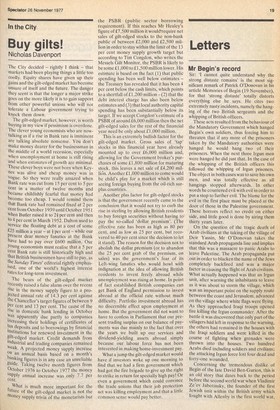In the City
Buy gilts!
Nicholas Davenport
The City decided — rightly I think — that markets had been playing things a little too coolly. Equity shares have given up their gains and the gilt-edged market has become unsure of itself and the future. The danger they scent is that the longer a major strike goes on the more likely it is to gain support from other powerful unions who will not tolerate a Labour gbvernment trying to knock them down.
The gilt-edged market, however, is worth buying in my view if pessimism is overdone. The clever young economists who are nowtalking as if a rise in Bank rate is imminent are talking absolute nonsense. YOu don't make money dearer for the businessman in the middle of a world recession, especially When unemployment at home is still rising and when estimates of growth are minimal. These clever boys were not born when Keynes was alive and cheap money was in vogue. So they were really amazed when Bank rate was cut from 15 per cent to 5 per cent in a matter of twelve months and became childishly fearful that money had become too cheap. I would remind them that Bank rate had remained fixed at 2 per cent from October 1939 until October 195 I When Butler raised it to 2+ per cent and then to 4 per cent in March 1952. Dalton used to service the floating debt at a cost of some £25 million a year — at + per cent — while our Present dear money fanatics at the Bank have had to pay over £600 million. Our Young economists must realise that a 5 per cent Bank rate is still historically high and that British businessmen have still to pay, as the Sunday Times' editorial rightly emphasised, one of the world's highest interest rates for long-term investment.
The bears of the gilt-edged market recently raised a false alarm over the recent rise in the money supply figure to a projected annual rate of 14.3 per cent against the Chancellor's target figures of between 9 Per cent and 13 per cent. The cause of the rise in domestic bank lending in October was apparently due partly to companies increasing their holdings of certificates of tax deposits and to borrowings by financial institutions for renewed investment in the gilt-edged market. Credit demands from industrial and trading companies remained weak. A projected money supply increase on an annual basis based on a month's banking figures is in any case an unreliable guide. Taking twelve month figures from October 1976 to October 1977 the money suPPly annual increase was only 7.7 per cent.
What is much more important for the future of the gilt-edged market is not the money supply trivia of the monetarists but the PSBR (public sector borrowing requirement). If this reaches Mr Healey's figure of £7,5.00 million it would'require net sales of gilt-edged stocks to the non-bank public of between £2,000 and £2,500 million in order to stay within the limit of the 13 per cent money supply growth target but according to Tim Congdon, who writes the Messels Gilt Monitor, the PSBR is likely to be some £1,000 to £1,500 million lower. His estimate is based on the fact (1) that public spending has been well below estimates — the Treasury has revealed that it has been 4 per cent below the cash limits, which points to a shortfall of £1,200 million —(2) that the debt interest charge has also been below estimates and (3) that local authority capital spending has been substantially below its target. If we accept Congdon's estimate of a PSBR of around £6,000 million then the net gilt-edged sales for the rest of the financial year need be only about (1,000 million.
This is an extremely bullish factor for the gilt-edged market. Gross sales of lap' stocks in this financial year have already mounted up to over £6,000 million and, allowing for the Government broker's purchases of some £1,800 million for maturing stock, this leaves a net sale of £4,200 millidn. Another £1,000 million to come would be child's play for a market which is still seeing foreign buying from the oil-rich surplus countries.
Another plus factor for gilt-edged stocks is that the government recently came to the conclusion that it would not try to curb the rise in sterling by allowing British residents to buy foreign securities without having to' pay the so-called 'dollar premium'. (The effective rate has been as high as 80 per cent, and as low as 25 per cent, but recovered to 40 per cent since the decision to let it stand). The reason for the decision not to abolish the dollar premium (or to abandon the 25 per cent grab of the premium, on sales) was the government's fear of its Left-wing fanatics who would howl with indignation at the idea of allowing British residents to invest freely abroad while unemployment was rising at home. In point of fact established British companies can get Bank of England permission to invest abroad at the official rate without much difficulty. Portfolio investment abroad has no discernible effect upon employment at home. But the government did not want to have to confess in Parliament that our pre sent trading surplus on our balance of payments was due mainly to the fact that over the years we built up our services and dividend-yielding assets abroad simply because our labour force has not been intei ested in makingtome-investment pay.
What a jump the gilt-edged market would have if investors woke up one morning to find that we had a firm government which had got the fire brigade to give up the right to strike in return for specially high pay! Or even a government which could convince the trade unions that their job protection act was killing employment and that a little common sense would pay better.






































 Previous page
Previous page